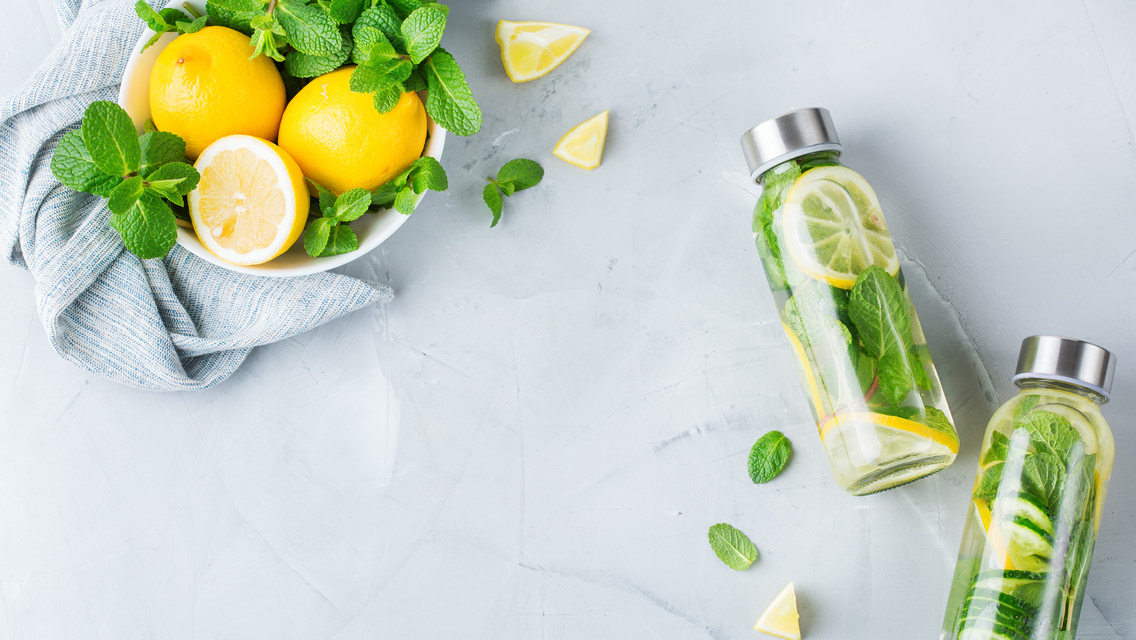Explore this article:
- How the Detox Process Works
- 6 Daily Habits to Boost Your Body’s Natural Detox Power
- 5 Common Detox Strategies
Year after year, the debate about the merits and dangers of detoxing rages on. Conventional medical professionals argue that the body’s impressive elimination system is all it needs to detoxify itself. Progressive and integrative health professionals argue that our bodies are overloaded with gunk, and that sensible detox programs offer an effective way of lightening our toxic burdens.
Both camps have a point.
It’s true that the body has a robust detoxification system built right in: The liver snags environmental toxins that circulate in the blood, the kidneys flush out digestive byproducts like uric acid and mineral buildup, and the lungs filter the air we breathe and expel the junky bits through exhalation and coughing (research on uric acid suggests that this waste product may be an important bellwether for cardiometabolic health. (Learn more at “Uric Acid: A New Metric for Heart Health.”) The skin eliminates toxins through sweat (and, in a pinch, blemishes), while the intestines host huge colonies of bacteria that neutralize toxic substances before evicting food wastes.
But it’s also true that our bodies aren’t always up to the detoxification challenges we modern humans throw their way, and that they tend to respond better to early, preventive care than to late, dramatic interventions.
Conventional medicine typically deals with toxicity issues only when the body’s own systems are at risk of totally shutting down: Dialysis machines are employed to replace the filtering action of failed kidneys; chelation therapies are used to remove impurities from poisoned blood.
Conventional medicine typically deals with toxicity issues only when the body’s own systems are at risk of totally shutting down: Dialysis machines are employed to replace the filtering action of failed kidneys; chelation therapies are used to remove impurities from poisoned blood. Conventional docs tend to write off the types of detox programs relatively healthy people embrace as both unnecessary and potentially dangerous.
Holistic health practitioners, meanwhile, point out that long before our organs show signs of failing, they show signs of overload and stress.
Holistic health practitioners, meanwhile, point out that long before our organs show signs of failing, they show signs of overload and stress. Given the unprecedented number of food-related and environmental toxins we all encounter on a daily basis, they argue, strengthening and supporting the body’s natural detoxification systems makes good common sense (See “Start Seeing Toxins” for more). It’s an effective way to protect and improve overall health and vitality, and may even help the body resolve longstanding health problems. Done right, they say, a good detox program can be a boon to our well-being.
So where does that leave us, the mostly healthy but semi-toxic masses? Most likely, somewhere in the middle — eager to dump unwanted toxins, but ambivalent about which detox programs are safe and healthy, and which might do more harm than good.
Ask a conventionally trained MD with an integrative, holistic or functional medicine background what he or she thinks about detox, and you’ll probably get a fairly balanced answer.
“Clearly, a healthy human body can handle certain levels of toxins,” says Elson M. Haas, MD, director of the Preventive Medical Center of Marin in San Rafael, Calif. “The concern we have is with excess intake of toxins or excess production of toxins or a reduction in the elimination process.” Such toxin-eliminating problems, Haas argues, are at the root of many chronic health complaints — from headaches and foggy thinking to digestive problems and excess weight.
Mark Hyman, MD, medical director of the UltraWellness Center in Lenox, Mass., and author of UltraMetabolism, agrees. He explains that under our current cultural conditions, our physical systems simply can’t keep up. “Unfortunately, our modern lifestyle exposes us to an increasingly complex (and deteriorating) environment, so that our detoxification systems must work overtime just to process the toxins we encounter in everyday life,” he says. “Many of us have exceeded our capacity for cleansing.”
In short, our impressive elimination systems need supplementary help in tough times. But what should that help really look and feel like? And how do we separate the health from the hype?
Quick Fixes vs. Sustainable Health
When the pop star Beyoncé Knowles lost 20 pounds in two weeks for a movie role in 2006, the Internet came alive with detox talk. Apparently Knowles had lost the weight using a lemon-water fast called “Master Cleanse,” and suddenly the cleanse was being widely promoted to people looking to quickly drop excess pounds.
But most health professionals advise against using such programs for weight loss, noting that they are both ineffective and potentially counterproductive.
Both Haas and Hyman suggest avoiding all extreme detox programs, including fasts, unless under a doctor’s care. Instead, they recommend more moderate, whole-food-based detox programs — often supported by carefully selected nutritional supplements — which they say are safer, more beneficial and less likely to negatively affect metabolism and cause subsequent weight gain.
Both Haas and Hyman suggest avoiding all extreme detox programs, including fasts, unless under a doctor’s care. Instead, they recommend more moderate, whole-food-based detox programs — often supported by carefully selected nutritional supplements — which they say are safer, more beneficial and less likely to negatively affect metabolism and cause subsequent weight gain.
Conducted over a period of days, weeks or even months, such programs result in more significant improvements in health and vitality, and they also tend to help people adjust their eating habits more permanently, resulting in the kind of sustainable weight loss most of us are after in the first place.
And yet it’s the quick-fix detox methods that seem to garner the most attention and excitement. Spas and salons offer ionic footbaths that turn the water varying colors as they supposedly suck toxins through the feet. Detoxifying body wraps offer to shrink off inches. Pricey cleansing kits with overnight promises sell like hotcakes.
Promises of speedy weight loss, in particular, make detox programs almost irresistible to body-conscious consumers. But the notion of detoxing and fasting purely for weight loss is a relatively new phenomenon and, according to most health experts, not an especially healthy one.
“If we look at fasting throughout history, we see that people have always fasted for the purpose of overall well-being and having insight into something deeper,” says Marc David, founder of the Institute for the Psychology of Eating in Boulder, Colo. “There are no historical references to fasting so as to look better in a bikini.”
David emphasizes the importance of taking a larger view when it comes to detoxing the body: A truly healthy detox process is about gaining physical and emotional vitality, he says, not losing pounds, achieving an unrealistic state of hygienic purity or finding an instant miracle cure for a chronic condition.
All the hype and overpromising associated with detoxing today creates a polarizing set of assumptions: Either detoxing is going to save your life, or all detox programs are snake oil. But these extreme views rarely tell the whole story.
Yes, any program that promises an instant fix is probably bunk, but healthy, effective detox plans abound, and some of them can make a real and noticeable difference in how you look and feel. You can tell them by the amount of patience and realistic effort they require, and by their intention to heal the body, not just shrink it.
Who Should Detox?
We can all benefit from some level of detox in today’s toxic environments, says Beverly Yates, who directs the Naturopathic Family Health Clinic in Mill Valley, Calif. But not everyone is a candidate for elimination-oriented programs.
Yates carefully examines prospective detox patients for signs of deficiency, like pale, puffy skin or discolored eyes. If a patient is too depleted, she will recommend nutrient supplements and fiber before starting a more intensive, unsupervised cleanse.
Unfortunately, those of us who are too depleted to start cleansing programs right away are usually the ones who need them the most. Haas and Yates agree that if your system is congested from years of overexposure to toxins, whether it’s from eating processed or allergenic foods, or experiencing chronic stress or carrying accumulated pounds from emotional eating, a supervised cleanse might be in order.
Unfortunately, those of us who are too depleted to start cleansing programs right away are usually the ones who need them the most.
This involves meeting with a naturopathic doctor or other trained nutrition professionals once or twice weekly, who can make sure you’re getting adequate nutrition, hydration and support while your body goes through the ups and downs of the healing process.
Yates also suggests supervision for anyone who suffers from digestive diseases, like colitis or diverticulitis, since insoluble fiber supplements can aggravate these conditions. It’s also a good idea to seek support if you have a history of eating disorders that might give fasting or detoxing an unhealthy emotional charge.
But for most of us, unsupervised mild detox programs and even daily rituals offer a range of benefits.
If you experience chronic headaches, low energy, bloating and skin outbreaks, for instance, it’s possible that your body is not processing toxins efficiently — in which case there are a variety of healthy detox approaches that can be helpful. These range from mild interventions, like adjusting your diet to include more nutrient- and fiber-rich whole foods and eliminating all things processed, to more intense ones, like briefly fasting with juice or broth.
If you experience chronic headaches, low energy, bloating and skin outbreaks, for instance, it’s possible that your body is not processing toxins efficiently — in which case there are a variety of healthy detox approaches that can be helpful.
The right approach for you will depend on the current state of your health, your time availability, and the problem you want to solve. “The key to proper treatment is to individualize your program,” says Haas.
The right approach also includes developing a healthy mindset. “Your biggest aid in detoxing is clear intent and commitment,” says Jane Alexander, author of Holistic Therapy File. This allows you to be guided by healthy intentions rather than driven by fear or a compulsive deprivation.
If weight loss is your only motivation, and you jump into the latest fast being used by Hollywood stars getting ready for their Oscar gowns, your program is likely to backfire.
“Fasting is generally too temporary an approach for overweight dieters and may even generate a feasting reaction coming off the fast,” says Haas.
Weight loss can indeed be a side effect of clearing the body’s “organs of elimination,” he explains, since the body will store toxins in fat to protect vital organs when it can’t eliminate them effectively. But if weight loss is to be maintained (Beyoncé gained her weight back immediately after filming), making an overall lifestyle change is the healthy and effective answer. “A better solution would be a more gradual change of diet that will replace old dietary habits and food choices with new ones,” Haas says (See “Raise Your Food Consciousness” to learn more).
How the Detox Process Works
Experts call the total amount of toxins stored in the body at a given time our toxic “body burden.” They note that when our total body burden passes a certain point, organs of elimination slow way down, kind of like your water filter when you haven’t changed it for a while.
Most detox programs work by replenishing necessary nutrients and removing stored toxins that are gumming up the works, which can have a variety of sources. “A toxin is basically any substance that creates irritating and/or harmful effects in the body . . . stressing our biochemical or organ functions,” says Haas. These include airborne pollutants like diesel fumes, synthetic household cleaners, and inflammatory food substances like refined sugar and caffeine, as well as common food allergens like gluten and dairy products. Elimination diets can be quite helpful, as in taking a couple of weeks’ break from sugar, caffeine, alcohol, wheat and dairy products.
But it’s not just what you take out of your diet that counts, it’s also what you put in. Take fiber, for example. “Previous generations of Americans ate 20 to 30 grams of fiber a day,” explains Ann Louise Gittleman, PhD, award-winning diet and detox professional and author of The Fast Track Detox Diet. “Our current average has dropped to less than 12. So the food we eat can sit in our colon for weeks.”
All detox programs work to clear out this gunk and replenish these organs. Off-the-shelf detox kits usually contain some combination of fiber (soluble and insoluble) with a chelating substance like bentonite clay, to absorb heavy metals.
Yates will sometimes recommend a high-quality detox kit to people who might be too busy or overwhelmed to measure out their own daily doses of clay and fiber. (If you have the time, these ingredients are available in bulk at a much lower cost.)
Gittleman recommends an 11-day program, with a seven-day period of nonallergenic whole foods, followed by a one-day juice fast and a three-day recovery with replenishing probiotic foods.
Hyman instructs patients to follow a program that eliminates allergenic foods and includes supplements, Epsom salts baths and yoga to help their bodies detox, but the length and frequency of the program varies according to a person’s needs.
All experts agree that some preparation — whether restoring nutrients, building up organ capacity, or weaning the body from refined foods — is important before starting a cleanse.
All experts agree that some preparation — whether restoring nutrients, building up organ capacity, or weaning the body from refined foods — is important before starting a cleanse.
The same applies to post-detox reentry: To seal the benefits of a cleanse, you need to return to regular eating slowly and deliberately, so your body has time to adjust.
Experts also agree that certain side effects are likely to accompany any detox process, both because the flood of toxins being released into the bloodstream can produce nausea, headaches and low energy, and because ceasing the intake of substances like coffee and sugar can lead to physical withdrawal.
Symptoms ranging from fatigue, headaches and irritability to potent breath, body odor and skin eruptions are all “signs that the detox process is working,” says Alex Jamieson, author of The Great American Detox Diet. These will usually disappear after the first few days of cleansing, as the release of toxins reaches an apex, and the body’s toxic burden starts to dissipate.
6 Daily Habits to Boost Your Body’s Natural Detox Power
A targeted cleanse is likely to produce at least some upset in your usual routine, especially when you first start out, so it might not be your best choice if you’re short on time and energy. Still, you don’t need to stop everything to offer more support to your body’s detoxifying efforts. You can also receive appreciable benefits from these daily detox habits:
1) Drink more water.
One of the easiest things you can do to support the healthy elimination of toxins is to drink plenty of water. “Our kidneys are fantastic waste removers,” says Jamieson. “They get rid of the waste products from protein metabolism — uric acid, urea and lactic acid — but they need lots of water to accomplish this.” Because we excrete 10 cups of water a day just by sweating, urinating and breathing, she recommends consuming no fewer than 10 glasses of water daily. (See “The Health Benefits of Drinking Water“.)
2) Eat your (organic) vegetables.
Adequate fiber and phytonutrients play a key role in supporting the body’s detoxification processes, and a steady supply of organic veggies will give you both. Hyman recommends that his patients eliminate refined and allergenic foods, sticking with a primarily whole-food diet.
Jamieson points out that a vegetarian diet based on organic whole foods has multiple detox advantages: It adds fiber, it reduces your exposure to toxins, and it’s easy. “When you switch to a diet based on vegetable proteins, you automatically consume fewer antibiotics, saturated fats, nitrates and hormones,” she says. “The switch allows your body to calm down, clean out and bulk up on healing nutrients, antioxidants and phytonutrients.” The “fast-track” detox diet Gittleman recommends does include some lean animal protein, but she recommends sticking strictly to pasture-raised meats, dairy products and eggs to avoid antibiotic and hormone byproducts.
3) Skin brushing and saunas.
Our bodies lose a significant amount of toxins through the skin, and both skin brushing and saunas can help amplify this process. Yates is a huge advocate of skin brushing; she tells her patients that it’s something they can do to detox every day. The only equipment you need is a skin brush — a long brush with coarse bristles and a long handle (available at most natural food stores). Brushing helps remove toxins from the surface of the skin as well as improve blood and lymph circulation. “Always brush from outward extremities toward the heart,” she says, which helps move the lymph fluid in the right direction and supports vascular valve function.
(Discover the dos and don’ts of dry brushing for skin health, plus get tips for doing it at home, at “How to Dry Brush for Healthy, Glowing Skin.”)
Saunas are also a terrific way to ship toxins out through the skin. For a true detoxifying effect, spend about 30 minutes in moderate heat — around 145 degrees. Most gym saunas are set between 180 and 195 degrees, so if the room is especially hot, shorten your stay.
4) Probiotics.
When they are working well, the bacteria in your colon neutralize and remove toxins from the body, so you want to give them plenty of support. Live-culture yogurt, kefir, kombucha tea and probiotic supplements are all easy ways to keep your fighting flora thriving and happy.
(For a guide to making the most of your body’s beneficial bugs — for gut health, immunity, metabolism and more — see “10 Ways to Get the Most Out of Probiotics and Boost Gut Health.”)
5) Garlic and cilantro.
Wisconsin-based nutritionist Karen Hurd recommends a daily dose of garlic as an easy way to remove heavy metals from the body. “Heavy metals are very attracted to the chemical compounds in garlic,” she explains, noting that they will actually unbind from soft tissue to bind with the sulfur present in garlic. She recommends raw garlic if your stomach can tolerate it and you’re seeking more rapid detox effects, but a daily ritual of a clove or two of sautéed garlic also works well to keep your system clear of heavy metals. (For centuries garlic has been worshiped for its protective powers and its culinary potential. See “How to Eat More Garlic” to learn more about this culinary gem.)
Studies have also shown the herb cilantro to help remove mercury and to have general antibacterial and anti-inflammatory properties.
6) Breathe deep.
Deep breathing activates the parasympathetic nervous system and helps us calm down (reducing a buildup of adrenal stress hormones), as well as releasing a significant load of toxins through exhalation. If we’re stressed, we tend to breathe more shallowly, and this prevents the usual release of toxins through the breath. (Discover how to breathe for strength, athletic performance, and meditation at “How to Breathe“.)
A magic cure it is not, but as a practical support for the body’s own intelligence and healing systems, a good detox program is hard to beat. If you keep the big picture in mind — detoxing for vitality rather than control and purity — you’ll be on the right track to a healthier, happier body.
Expert Opinions on 5 Common Detox Strategies
The following detox strategies have generated a lot of talk, but do they work? Here’s what some experts have to say.
1) Epsom salts and baking soda baths. Mark Hyman, MD, and Beverly Yates, ND, both recommend hot Epsom salt baths to their patients as a gentle, effective detox method during a cleanse or anytime. Epsom salts contain a generous amount of magnesium, a calming mineral that can be absorbed through the skin, and hot water produces a gentle sweat that lets toxins out. Yates says that releasing toxins through the skin can “give kidneys a break.” Adding baking soda helps prevent dry skin.
2) Detox footbaths. Soaking the feet always feels good, but ionic footbaths that purportedly remove toxins through the feet (and turn the water brown) have no scientific support. Some critics argue that the only reason the water turns brown is because the ionic charge has a corrosive effect on the salt in the water. Detox foot pads held over steam show dark stains similar to those that have been plastered to feet, suggesting that heat and moisture, not toxin-drawing powers, are responsible for the results.
3) Master Cleanse. Created in 1941 by Stanley Burroughs, an early raw-food advocate, the Master Cleanse involves a 10-day fast using water mixed with lemon juice, maple syrup and cayenne pepper. Elson M. Haas, MD, of the Preventive Medical Center of Marin in San Rafael, Calif., does recommend this to some of his patients as a “spring cleanse,” especially if they are experiencing congestion related to overconsumption of processed foods, but he supervises them carefully throughout the fast. “Medical supervision is important for anyone in poor health or without fasting experience,” he says. He doesn’t recommend Master Cleanse for weight loss, however. For excess weight, he recommends long-term dietary shifts to avoid an unhealthy boomerang.
4) Colon cleanses. Yates will sometimes suggest over-the-counter kits for people who are new to detox and feel more comfortable having measured ingredients and instructions. Still, most colon-cleansing kits contain fairly simple combinations of bentonite clay and fiber (along with herbs that help speed elimination), and you can buy these ingredients in bulk (or packaged à la carte) at any natural food store for much less money than the typical kit. And remember: Kits sold on TV are a risky financial bet, since they often rope you into “memberships” with monthly deliveries — and monthly charges to your credit card that can be hard to cancel.
5) Colonics. Colonics are essentially professional enemas; they involve working with a health professional who uses water and herbal combinations to cleanse the colon. According to some experts, colonics can be effective at clearing out stored waste, but they are generally unnecessary and may prove risky for some people. They can disturb the normal pressure of fluids in the colon, upset the balance of intestinal bacteria, and possibly encourage an unhealthy, obsessive mindset in some individuals.
This article originally appeared as “Detox Done Right” and has been updated. It originally appeared online on April 1, 2010.





This Post Has 0 Comments